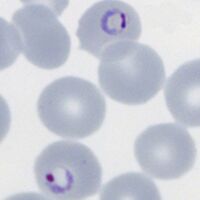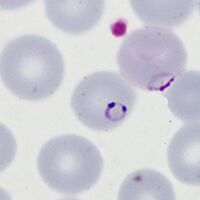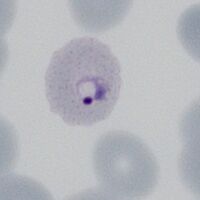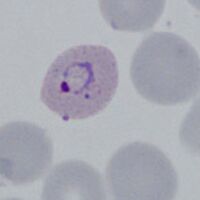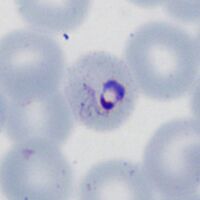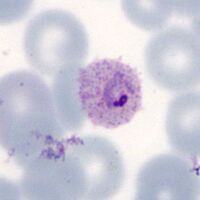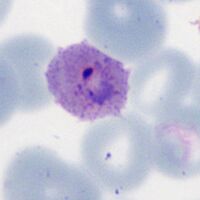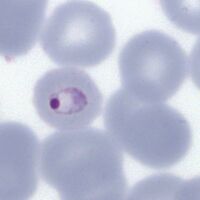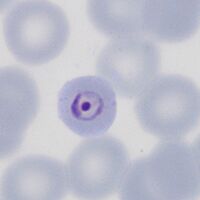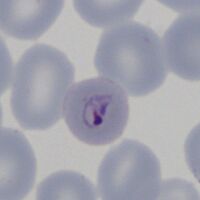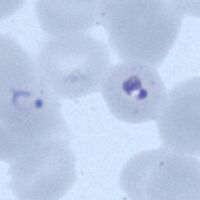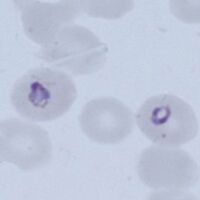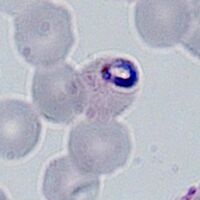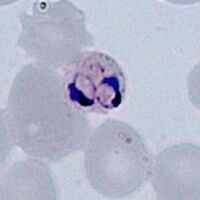Gallery of early trophozoites: Difference between revisions
From haematologyetc.co.uk
No edit summary |
No edit summary |
||
| (45 intermediate revisions by the same user not shown) | |||
| Line 1: | Line 1: | ||
---- | ---- | ||
'''Navigation'''</br> | '''Navigation'''</br> | ||
[[ | [[Galleries|Go Back]] | ||
---- | |||
'''General Comments''' | |||
This stage effectively runs continuously into the late trophozoite stage: at the very earliest point all trophozoites appear as ring forms, and species differences are very difficult to distinguish - the "species specific" elements only appear as parasites mature.</br></br>'''Notes''':</br> | |||
1. Features such as cytoplasmic dots depend on stain quality and are not easily detected if slides are not [[staining pH|stained using recommended protocols]] (see this page).</br> | |||
2."Species-specific" features are never entirely specific: appearances such as double dot forms, multiply infected cells etc. may ve more frequently seen in some species but it is the overall features that count - for more information see the blue links in the descriptions. | |||
---- | ---- | ||
<span style="font-size:95%">''' ''P.falciparum'' '''</span></br> | <span style="font-size:95%">''' ''P.falciparum'' '''</span></br> | ||
<span style="font-size:95%">Small delicate rings, within red cells of normal (or slightly crenated) appearance. Some parasite forms are typical though not exclusive of the species, these include: accolé forms, double chromatin dot forms, and multiple parasites within infected red cells. | <span style="font-size:95%">Small delicate rings, within red cells of normal (or slightly crenated) appearance.</br>These may be the only forms seen in some patients at diagnosis.</br>Some parasite forms are typical though not exclusive of the species, these include: [[Accolé form|accolé forms]], [[Double chromatin dot forms|double chromatin dot forms]], and [[multiple parasites]] within infected red cells. Cytoplasmic dots will not generally be found in early trophozoites. | ||
<gallery mode="traditional" widths=200px heights=200px> | <gallery mode="traditional" widths=200px heights=200px> | ||
| Line 15: | Line 22: | ||
---- | ---- | ||
<span style="font-size:95%">''' ''P.vivax'' '''</span></br> | <span style="font-size:95%">''' ''P.vivax'' '''</span></br> | ||
<span style="font-size:95%">Rings begin as small forms in normal sized red cells, but as they develop both parasites and red cells become | <span style="font-size:95%">Rings begin as small forms in normal sized red cells, but as they develop both parasites and red cells become markedly [[Size and shape of infected red cells|enlarged and irregular]]. [[Schuffners dots]] develop during this stage initially as a fine dusting but becoming more prominent. | ||
<gallery mode="traditional" widths=200px heights=200px> | <gallery mode="traditional" widths=200px heights=200px> | ||
File:PVET1g.jpg|<span style="font-size:80%"> | File:PVET1g.jpg|<span style="font-size:80%">Early ring form</span>|link={{filepath:PVET1g.jpg}} | ||
File:PVET2g.jpg|<span style="font-size:80%"> | File:PVET2g.jpg|<span style="font-size:80%">Early ring form</span>|link={{filepath:PVET2g.jpg}} | ||
File:PVET3g.jpg|<span style="font-size:80%"> | File:PVET3g.jpg|<span style="font-size:80%">Intermediate trophozoite</span>|link={{filepath:PVET3g.jpg}} | ||
File:PVET4g.jpg|<span style="font-size:80%"> | File:PVET4g.jpg|<span style="font-size:80%">Intermediate/late trophozoite</span>|link={{filepath:PVET4g.jpg}} | ||
</gallery>" | </gallery>" | ||
---- | |||
<span style="font-size:95%">''' ''P.ovale'' '''</span></br> | |||
<span style="font-size:95%">As with the other species development begins with small forms and normal red cells; However as the species develops cahnges to red cells begin that might include [[fimbriation]], [[ovoid form]] and some enlargement. Similar to ''P.vivax'' the cytoplasmic James (Schuffners) dots appear initially as a fine dots but becoming more prominent as the parasites mature. | |||
<gallery mode="traditional" widths=200px heights=200px> | |||
File:POET1g.jpg|<span style="font-size:80%">Early ring form</span>|link={{filepath:POET1g.jpg}} | |||
File:POET2g.jpg|<span style="font-size:80%">Ring with dots/fimbriation</span>|link={{filepath:POET2g.jpg}} | |||
File:POET3g.jpg|<span style="font-size:80%">faint Ziemann's dots</span>|link={{filepath:POET3g.jpg}} | |||
File:POET4g.jpg|<span style="font-size:80%">Ring early ovoid change</span>|link={{filepath:POET4g.jpg}} | |||
</gallery>" | |||
---- | |||
<span style="font-size:95%">''' ''P.malariae'' '''</span></br> | |||
<span style="font-size:95%">Generally parasites are infrequent. The very early small forms become a little more robust than ''P.falciparum'', and may acquire features more typical (though not exclusive) for species including [[central chromatin dot]] forms, and early parasite [[elongation]] or angular forms. Red cells have normal size and shape or may have reduced size, cytoplasmic dots should not be present (although the uncommon fine Stinton's dots may be seen). | |||
<gallery mode="traditional" widths=200px heights=200px> | |||
File:MET1g.jpg|<span style="font-size:80%">Ring form in small red cell</span>|link={{filepath:MET1g.jpg}} | |||
File:MET2g.jpg|<span style="font-size:80%">The central chromatin dot</span>|link={{filepath:MET2g.jpg}} | |||
File:PMET3g.jpg|<span style="font-size:80%">Early elongation, Stinton's dots</span>|link={{filepath:MET3g.jpg}} | |||
File:MET4g.jpg|<span style="font-size:80%">Early angularity of form</span>|link={{filepath:MET4g.jpg}} | |||
</gallery>" | |||
---- | |||
<span style="font-size:95%">''' ''P.knowlesi'' '''</span></br> | |||
<span style="font-size:95%">At the early trophozoite stage an infection by ''P.knowlesi'' resembles that of ''P.falciparum'' and the number of infected cells amy be high. Forms found may also resemble P.falciparum with parasites that have double chromatin dots, multiply infected red cells, or accolé forms. This may create diagnostic difficulty in cases where only early trophozoites are present. Later forms however begin to resemble parasites of ''P.malariae'' and these should be specifically sought where infections arise in geographical areas associated with this parasite. | |||
<gallery mode="traditional" widths=200px heights=200px> | |||
File:PKET1.jpg|<span style="font-size:80%">Fine early rings</span>|link={{filepath:PKET1.jpg}} | |||
File:PKET2a.jpg|<span style="font-size:80%">Double dot (right)</span>|link={{filepath:PKET2a.jpg}} | |||
File:PKET3a.jpg|<span style="font-size:80%">Accolé form</span>|link={{filepath:PKET3a.jpg}} | |||
File:PKET4a.jpg|<span style="font-size:80%">Multiple infection</span>|link={{filepath:PKET4a.jpg}} | |||
</gallery> | |||
---- | ---- | ||
Latest revision as of 18:59, 6 June 2024
Navigation
Go Back
General Comments
This stage effectively runs continuously into the late trophozoite stage: at the very earliest point all trophozoites appear as ring forms, and species differences are very difficult to distinguish - the "species specific" elements only appear as parasites mature.
Notes:
1. Features such as cytoplasmic dots depend on stain quality and are not easily detected if slides are not stained using recommended protocols (see this page).
2."Species-specific" features are never entirely specific: appearances such as double dot forms, multiply infected cells etc. may ve more frequently seen in some species but it is the overall features that count - for more information see the blue links in the descriptions.
P.falciparum
Small delicate rings, within red cells of normal (or slightly crenated) appearance.
These may be the only forms seen in some patients at diagnosis.
Some parasite forms are typical though not exclusive of the species, these include: accolé forms, double chromatin dot forms, and multiple parasites within infected red cells. Cytoplasmic dots will not generally be found in early trophozoites.
"
P.vivax
Rings begin as small forms in normal sized red cells, but as they develop both parasites and red cells become markedly enlarged and irregular. Schuffners dots develop during this stage initially as a fine dusting but becoming more prominent.
"
P.ovale
As with the other species development begins with small forms and normal red cells; However as the species develops cahnges to red cells begin that might include fimbriation, ovoid form and some enlargement. Similar to P.vivax the cytoplasmic James (Schuffners) dots appear initially as a fine dots but becoming more prominent as the parasites mature.
"
P.malariae
Generally parasites are infrequent. The very early small forms become a little more robust than P.falciparum, and may acquire features more typical (though not exclusive) for species including central chromatin dot forms, and early parasite elongation or angular forms. Red cells have normal size and shape or may have reduced size, cytoplasmic dots should not be present (although the uncommon fine Stinton's dots may be seen).
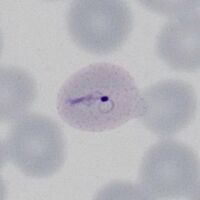
Early elongation, Stinton's dots
"
P.knowlesi
At the early trophozoite stage an infection by P.knowlesi resembles that of P.falciparum and the number of infected cells amy be high. Forms found may also resemble P.falciparum with parasites that have double chromatin dots, multiply infected red cells, or accolé forms. This may create diagnostic difficulty in cases where only early trophozoites are present. Later forms however begin to resemble parasites of P.malariae and these should be specifically sought where infections arise in geographical areas associated with this parasite.

